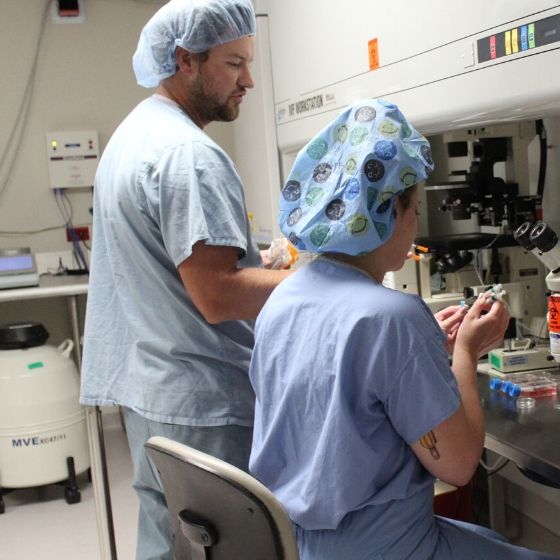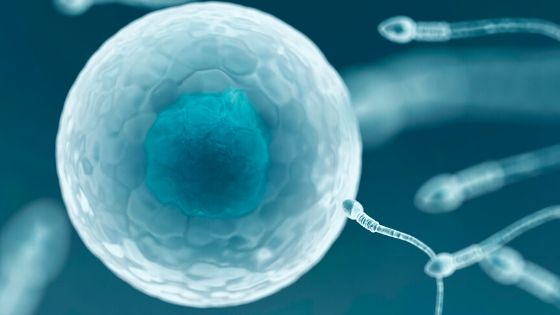Overview
In Vitro Fertilization (IVF) is a medical procedure where eggs are obtained via an ovarian stimulation protocol individualized for you, followed by an oocyte retrieval, then the viable eggs are fertilized by sperm outside of your body, followed by an embryo transfer into your uterus. In actuality, IVF is a complex multi-step process of assisted reproductive technology (ART) with the ultimate goal being achieving a successful, single, viable intrauterine pregnancy.
IVF is a widely used procedure and has the highest success rate of any ART procedure, and while it has minimal risks, it is generally very safe. According to the American Society of Reproductive Medicine (ASRM), over 8 million babies have been born from IVF since it was first introduced in 1978.
The IVF Process
IVF is broken down into four stages:
Controlled Ovarian Stimulation and Monitoring
Fertility medications are used to stimulate the ovaries to develop multiple follicles. Follicles are fluid-filled sacs that contain an egg. Generally, not every egg is able to be fertilized and develop into an embryo, so the more mature eggs there are to fertilize, the better. Also not all of the eggs that are retrieved will be genetically normal. The percentage of genetically normal eggs is related directly to maternal age. Follicle development is monitored through regular (every few days) ultrasounds and blood tests to evaluate the follicles and adjust protocol as necessary.
Personalized Stimulation Protocols
Every patient has unique conditions and circumstances, so a personalized stimulation protocol is recommended by Dr. Davies. A type of medication group called Gonadotropins will stimulate the ovaries to develop more eggs. Gonal F, Follistim, and Menopur are brand names of this type of medication.Ovulation Suppression
To make sure you do not ovulate the developed eggs before they are ready to be retrieved, another type of medication is typically given. Ganirelix is the most common ovulation suppression drug used in this process, although there are other options such as Lupron. If, when and how much varies from patient to patient.Trigger Shot
Once the eggs have developed, a Lupron trigger or a shot of hCG (human chorionic gonadotropin) is administered. This prepares the ovaries to fully mature the oocytes. Egg retrieval is typically scheduled around 35 hours after the trigger shot is given.Oocyte (Egg) Retrieval
Oocyte retrieval is a minor surgical procedure that removes the developed eggs from the ovaries. Local anesthesia and IV sedation are used to reduce any potential patient discomfort. During the retrieval process, an ultrasound probe is inserted into the vagina. A very thin needle is then guided to the follicles for gentle suction removal of the eggs. The eggs are then placed into a culture and incubated until ready for fertilization. The oocyte retrieval typically takes 20 minutes or less to complete. If the patient is continuing with the Embryo Transfer, they will move on to the next step. If the patient is freezing their embryos or eggs for later use, they will not move on to the next step until they are ready to become pregnant. Patients may feel minor bloating, cramping or mild discomfort for a few days after the procedure.Fertilization
Fertilization is when sperm and egg combine to create a zygote. A semen sample is usually obtained by ejaculation to combine with the eggs. In conventional insemination, the sperm and eggs are placed together and incubated overnight for fertilization to occur. Intracytoplasmic sperm injection (ICSI) is often and successfully used to fertilize the eggs. In this procedure, a single sperm is injected into an egg to achieve fertilization. In certain situations, the doctor may suggest using assisted zona hatching (AZH) and/or preimplantation genetic testing (PGT) prior to embryo transfer.
Embryo Transfer:
An embryo(s) is usually transferred into the uterus during a frozen embryo transfer or during a fresh transfer. This procedure does not usually involve sedation or anesthesia. The physician uses a catheter to place the embryo(s) into the uterine cavity under ultrasound guidance. When successful, an embryo will implant in the lining of the uterus. If there are extra embryos, they may be vitrified (frozen) for later use, if desired. One typical IVF cycle takes about two weeks from stimulation to transfer. Pregnancy is confirmed by a blood test 12-14 days after the embryo transfer.
IVF Success Rate
The success rate of IVF depends on multiple factors such as the patient’s age, past medical history, and the type of treatment plan. It is very important to understand that pregnancy rates are not the same as live birth rates. In the United States, the live birth rates for all certified clinics can be found on the website of the Society for Assisted Reproductive Society.
When Is IVF Needed?
IVF is typically used when either partner has:
- Tried other procedures (like IUI) without success
- History of miscarriage/pregnancy loss
- Fallopian tube damage or blockage
- Ovulation disorders
- Premature ovarian failure
- Endometriosis
- Uterine fibroids
- Previous tubal sterilization
- Impaired sperm production or function
- Unexplained infertility
- Genetic disorders
- Other health conditions such as previous cancer treatment
- LGBTQ family building needs
- Single parent family building
Preparing For an IVF Cycle
Because infertility alone and the IVF process can be emotionally taxing, it is important to be set up for success as much as possible.
Testing
Before a patient can move forward with an IVF cycle, both partners (or donors, if applicable) need to be fully evaluated to be sure they are good candidates for IVF. In addition to the initial evaluation, other tests may be needed such as:
Ovarian Reserve- A set of blood tests and ultrasounds estimate how many eggs are left in a woman’s ovaries as well as how a woman will respond to the ovarian stimulation medications in an IVF cycle.
Semen Analysis- If not already done, or too much time has passed since a previous semen analysis, one will be completed.
Uterine Examination- Various tests can be done, such as a hysterosonogram, to check for uterine abnormalities, blockages, etc.
Lifestyle Changes
Maintaining a healthy lifestyle is recommended anytime, but especially before and during an IVF cycle. Quitting bad habits like smoking, illegal substances or alcohol, achieving and maintaining a healthy weight, eating healthy foods and reducing stress can help prepare the body for the vigorous IVF process.
Assisted reproductive technology (ART) involves a significant physical, financial, and emotional commitment on the part of the patient and couple. If you are interested in learning more about our IVF process or want to set up a consultation, please contact us.

